Pinch point
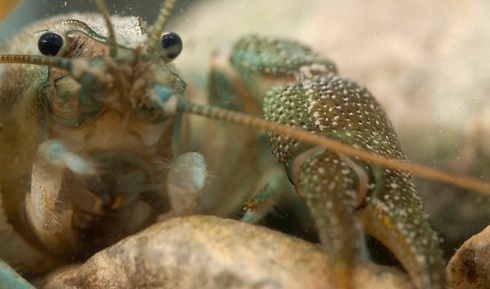
Alli Cartwright is one of a small number of conservationists captive-breeding the endangered white-clawed crayfish – helping this keystone species battle invasive competitors and the ‘crayfish plague’
December 4th 2020
Walking into the room of aquaculture tanks the waters appear tranquil. With little or no movement one would be forgiven for thinking that no life resides here. But just underneath the water’s surface a small clawed creature peers up to meet my gaze. Expecting a feast of bloodworms, this little one is unaware of the ensuing threat to its species. The white-clawed crayfish (Austropotamobius pallipes) could well become globally extinct in years to come, partly due to their own invasive cousins.
For more than seven years I have worked with endangered white-clawed crayfish in captivity for conservational purposes. Their sharp claws can be intimidating at first – their little pincers ready to snap in an instant – but once they become acquainted with you they can be affectionate, approaching with claws lowered ready for me to rub their carapace (upper shell). It is easy to admire their amusing waddle as they walk on land, and their spurting backwards swimming in water. I am one of the few people to have the privilege of working with this endangered species as a licence is required to handle them.
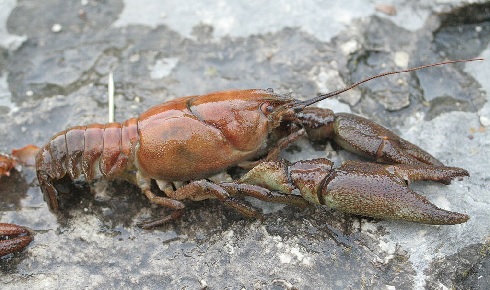 'Renowned escape artist' and keystone species the white-clawed crayfish (Austropotamobius pallipes)
'Renowned escape artist' and keystone species the white-clawed crayfish (Austropotamobius pallipes)In the wild they are found across northern Europe. It is the only freshwater crayfish species naturalised to the UK and Ireland (although originally introduced from mainland Europe[1]). These crayfish inhabit selected rivers and lakes, but are generally rare. The calcium content of the water needs to be above 5mg L-1 for sufficient shell production and they also require heterogeneous habitats with refuge sites, such as stones or artificial structures, to help them hide from predators and one another[2].
Most crayfish are considered keystone species, providing ecosystem services through their feeding habits: wild crayfish are omnivorous, feeding from many levels of the aquatic food web, including invertebrates (e.g. Gammarus), plant matter and woody fragments, thus making them important for the recycling of nutrients contained in detritus. These little omnivores are also partial to eating each other, and when the young first depart from their mother’s side a free-for-all buffet can commence. Further to breaking down organic matter, they oxygenate benthic sediment as they disturb it during their activities, bringing oxygenated water into the sediment. This makes crayfish important for the recycling of nutrients in the aquatic food web and for keeping benthic sediment oxygenated.
Throughout its range the white-clawed crayfish is classified as endangered, with these declines largely attributed to human activities. We have altered their rivers by changing the waterbody directly, such as adding dams, preventing migration of the species, or by removing the necessary shelters when waterways are dredged or straightened. Changing land management regimes, such as logging and agriculture, also introduces more sediment to the waterways. An increase in suspended sediment affects crayfish respiration by blocking their gills and preventing adequate oxygen supply.
Crayfish are also sensitive to pollutants, including pesticides, that can enter rivers. They seem to be particularly susceptible to fluoride-containing pesticides, which can alter their behaviour, inhibiting their movement so they are less effective at evading predators. Further exposure to fluoride-containing pesticides can prevent them from feeding.
Escape to the country
Since the 1970s seven invasive crayfish have been introduced to Great Britain, including the signal crayfish (Pacifastacus leniusculus), narrow-clawed crayfish (Astacus leptodactylus), spiny-cheek crayfish (Orconectes limosus) and red swamp crayfish (Procambarus clarkii). These were introduced for food production in aquaculture, due to their larger size, or traded as pets. In Ireland three crayfish species are traded as pets, posing an introduction risk – with one wild population of the yabby (Cherax destructor) now confirmed on the island.
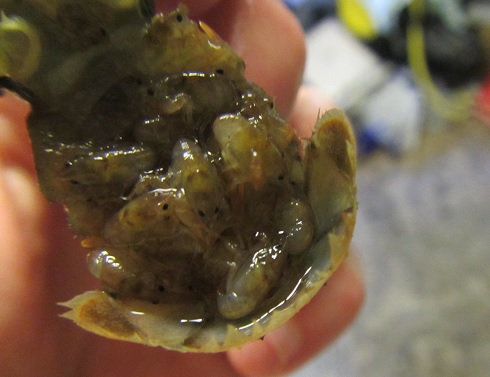 Juvenile white-clawed crayfish attached to the underside of a female. Image by Alli Cartwright.
Juvenile white-clawed crayfish attached to the underside of a female. Image by Alli Cartwright. Crayfish are renowned escape artists. I have spent many hours searching for escapees and have learned to tread very lightly when entering the room. They can also survive out of water for a surprisingly long time – I once found a missing crayfish two weeks after disappearing when she attacked my foot from under my desk. This means all species intended to be confined to aquaculture sites in Great Britain have escaped and established in the wild. The signal crayfish in particular has become established in large parts of England and Wales, with some occurrences in Scotland.
One of the biggest challenges created by the introduced crayfish is their ability to carry diseases, particularly the crayfish plague, to which many introduced species are immune, but the white-clawed crayfish is not. The crayfish plague is caused by an oomycete (fungi-like organism) called Aphanomyces astaci.
When the oomycete produces spores they are attracted to the chitin that make up the crayfish’s body and embed themselves ready for growth. The spores then produce mycelium (root-like structures), which reach the nerve chord of the crayfish, leading to its death. Once its host dies the oomycete bursts the crayfish’s body open to release its spores and restart the cycle. Some populations of white-clawed crayfish, including one in Spain[3], are believed to be resistant to the plague, but white-clawed crayfish in the UK have no immunity to this disease.
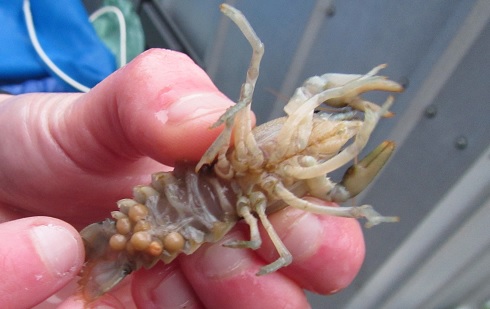 White-clawed crayfish eggs. A small number of licenced captive breeders are helping repopulated areas of the UK where the species has been killed by plague or outcompeted. Image by Alli Cartwright.
White-clawed crayfish eggs. A small number of licenced captive breeders are helping repopulated areas of the UK where the species has been killed by plague or outcompeted. Image by Alli Cartwright. The crayfish plague is primarily carried by non-native crayfish, but can also be carried on fishing gear and water sports equipment. Without adequate cleansing between sites, equipment infected with the plague oomycetes can transfer the pathogen between waterbodies. Contaminated fishing equipment is thought to be the cause of crayfish plague in Ireland, as signal crayfish have not been found in the wild there. The only positive aspect is that the pathogen is short-lived outside its crayfish host. This means the death of white-clawed crayfish is often a tragic single event as opposed to a prolonged decline, allowing the species to recover, provided further disturbances or contamination do not occur.
Waterways that lose their crayfish will potentially change forever. As outlined above, crayfish help recycle detritus vital for the carbon cycle and growth of aquatic vegetation. They also oxygenate benthic sediments and provide food for predatory fish, mammals and birds. While the same is true for many of the introduced crayfish, their larger size means they can predate fish, particularly juveniles, and thus alter fish populations.
For example, the fry of the endangered Atlantic salmon (Salmo salar, also in decline largely due to human alteration to rivers, including dam building) are too large to be predated on by white-clawed crayfish, but can be consumed by non-native crayfish, potentially reducing their numbers further.
Larger introduced crayfish require more food and so also compete with other aquatic organisms for plant and animal food sources. Many non-native crayfish also have greater breeding success and so quickly reach populations far greater than native species could and further dominate the environment. Therefore, by protecting the white-clawed crayfish other species in the waterbodies will benefit, but first we need to turn the tide on their decline.
Although the species is endangered, there is still hope for the white-clawed crayfish. Programmes are under way to eradicate non-native crayfish, reintroduce the white-clawed crayfish and educate the public. In Great Britain there are efforts to eradicate the signal crayfish in particular and stop it spreading into new water systems. Eradication efforts include trapping, placing barriers to prevent invasion, biocidal controls, RNA interference, predation, and methods to reduce reproduction such as male sterilisation, monosex populations and autocidal controls.
Rarely growing over 12cm, the white-clawed crayfish breeds in autumn when temperatures drop below a cool 10°C. Females can produce 50 to 100 eggs, which are protected by their pleopods (tails) until they hatch. This process usually begins from April to June, when those lucky enough to work with crayfish can view these little creatures wriggling on their mother’s pleopods until they are ready to embrace and explore the unknown waters after their second moult. Once free-swimming, they are miniature versions of the adult, but have to wait some time before reaching sexual maturity, which usually occurs after 11 to 12 moults, by which time they are around 16 months old if kept in captivity or two to three years old in the wild or non-heated aquarium tanks[5,6]. They can live to 12, but rarely survive this long, especially in the wild.
While trapping has been the most widely employed method, it only has a short-term success as breeding soon replaces the lost individuals. BBC Food has designed a range of recipes to encourage trapping non-native crayfish, but this requires a licence and can increase the population when larger, dominant individuals are removed, allowing others to reproduce.
The use of biocides is more successful, especially in isolated waterbodies. However, because many biocides are non-selective they will impact other aquatic fauna – and so the solution to control non-native crayfish has to be specific to each site. There is also the risk that any non-selective biocide could kill the white-clawed crayfish too if any remain in the waterbody undetected.
If the non-native crayfish can be eradicated, thus removing the source of crayfish plague, the white-clawed crayfish can be reintroduced from stocks bred in captivity. Such projects involve a range of organisations, from private hatcheries to zoos. The crayfish can be reintroduced from captive stocks or transported to ‘ark sites’ (isolated, self-contained sites that can support healthy populations) if they are at risk from invasive crayfish introduced to their waterbody.
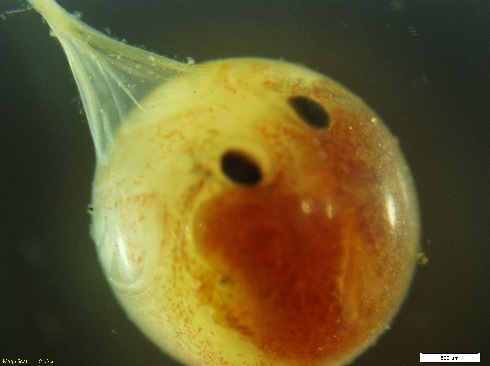 Breeders have developed their own methods for preventing fungal infections, where the crayfish eggs are removed and incubated artificially. Image by Alli Cartwright.
Breeders have developed their own methods for preventing fungal infections, where the crayfish eggs are removed and incubated artificially. Image by Alli Cartwright. Wild-caught white-clawed crayfish can only be collected with licences that allow some individuals – often females with eggs – to be captured and relocated to aquaculture facilities for captive rearing. Either way, successful egg incubation is key to the success of any crayfish aquaculture site.
Egg incubation may sound simple, but once there are eggs the next fight begins: a battle against microorganisms. The crayfish mother keeps the eggs under her abdomen for the whole incubation (and for around two weeks after they hatch), occasionally opening and closing her abdomen to bring fresh, clean water to the eggs. Each pass of water brings new microorganisms, mainly fungi, which could infect her developing eggs.
Crayfish breeders and conservationists fear the fungi – which can and does cause the total loss of the mother’s eggs. Thankfully, nature has a solution. The crayfish mothers tend to their eggs, removing dead ones with a small claw-like appendage at the end of each leg. This ideally stops the spread of natural fungi from one egg to the next. Breeders can detect a colour change after the egg has died and been removed, but the mother can identify it as dead before there is any visible change.
Breeders have developed their own methods for preventing fungal infections, where the eggs are removed and incubated artificially[2,4]. The major advantage of this is that the temperature that controls the embryonic development can be altered more easily. When it is increased hatching will occur sooner, increasing the period for post-hatching growth within the first growing season. It also means that the eggs are not lost from detachment, the mother’s death or cannibalisation.
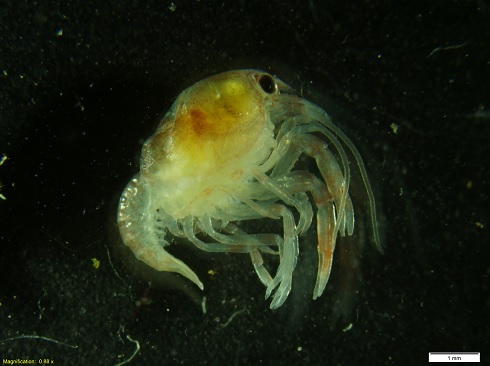 Post-hatching juveniles swim on their side until their second moult when they become free-swimming. Under natural incubation they remain attached to their mother. Image by Alli Cartwright.
Post-hatching juveniles swim on their side until their second moult when they become free-swimming. Under natural incubation they remain attached to their mother. Image by Alli Cartwright. Once crayfish have been reared in aquaculture facilities they can be reintroduced to waterways where they were or are present, or to ark sites with suitable water systems where they were not previously found. Hatchery-reared crayfish have successfully been reintroduced to locations including the River Witham in Lincolnshire and the River Lathkill in Derbyshire. They have also been successfully introduced to a number of ark locations including 17 sites in southern England, one in northern England, three sites in Wales, two in Scotland, one in Northern Ireland and four in the Republic of Ireland[4].
Reintroduction of the species could prove to be one of the best methods to prevent further reduction in the white-clawed crayfish populations throughout Europe. The Irish crayfish stock in particular would be suitable for reintroduction into England, France, Germany and Switzerland because they are genetically similar.
Conservation outreach
It is nearly impossible to eradicate non-native crayfish, so the best strategies involve preventing the further introduction of non-native crayfish and more widespread disinfecting of equipment being used across different waterbodies. Education is required for both of these. The identification and confiscation of just one shipment of non-native crayfish in Dublin prevented the potential introduction of these crayfish, which may have carried the plague, to the entire region.
Education programmes to raise awareness of the crayfish plague can be combined with awareness of other undesirable species such as zebra mussels (Dreissena polymorpha) and encourage water users to check, clean and dry all equipment between sites. If this is not possible, the use of disinfectants or steam cleaning is encouraged. Many jetties in Northern Ireland display signs reminding people to clean their equipment appropriately.
Only with these measures in place across the UK and Ireland do we have a chance of fighting the crayfish plague. I long for a day when reports cease of plague-killed crayfish bodies washed up on the edges of rivers and lakes.
Finally, in addition to education about the non-native crayfish and the plague, there needs to be education on the white-clawed crayfish themselves. Further to the hatchery rearing, my group visits schools to teach children about the crayfish and why they are important for the environment. I hope to inspire future generations to care for the white-clawed crayfish. Without this my favourite species is destined to join the dinosaurs.
Alli Cartwright is a former researcher who works as a technician and science communicator. Her passions are ecology, microbiology and crayfish.
1) Souty-Grosset, C. et al. Atlas of Crayfish in Europe (Muséum national d’Histoire naturelle, Paris, 2006).
2) Reynolds, J. D. The current status of white-clawed crayfish in Ireland. In Crayfish Conservation in the British Isles (eds Brickland, J. et al) 35–41 (Proceedings of a conference held on 25th March 2009 in Leeds, UK).
3) Matin-Torrijos, L. et al. Resistance to the crayfish plague, Aphanomyces astaci (Oomycota) in the endangered freshwater crayfish species Austropotamobius pallipes. PLoS ONE 12(7), 1–13 (2017).
4) Policar, T. et al. Sodium chloride as effective antifungal treatment for artificial egg incubation in Austropotamobius pallipes. Knowl. Manag. Aquat. Ecosyst. 401(13), 1–6 (2011).
5) Carral, J. M. et al. Effect of dead egg removal frequency on stage 2 juvenile production in artificial incubation of Austropotamobius pallipes Lereboullet. Bull. Fr. Pêche Piscic. 372–373, 425–430 (2004).
6) Nightingale, J. et al. The use of ark sites and associated conservation measures to secure the long-term survival of white-clawed crayfish in the UK. Int. Zoo.Yearb. 51(1), 50–68 (2017).


